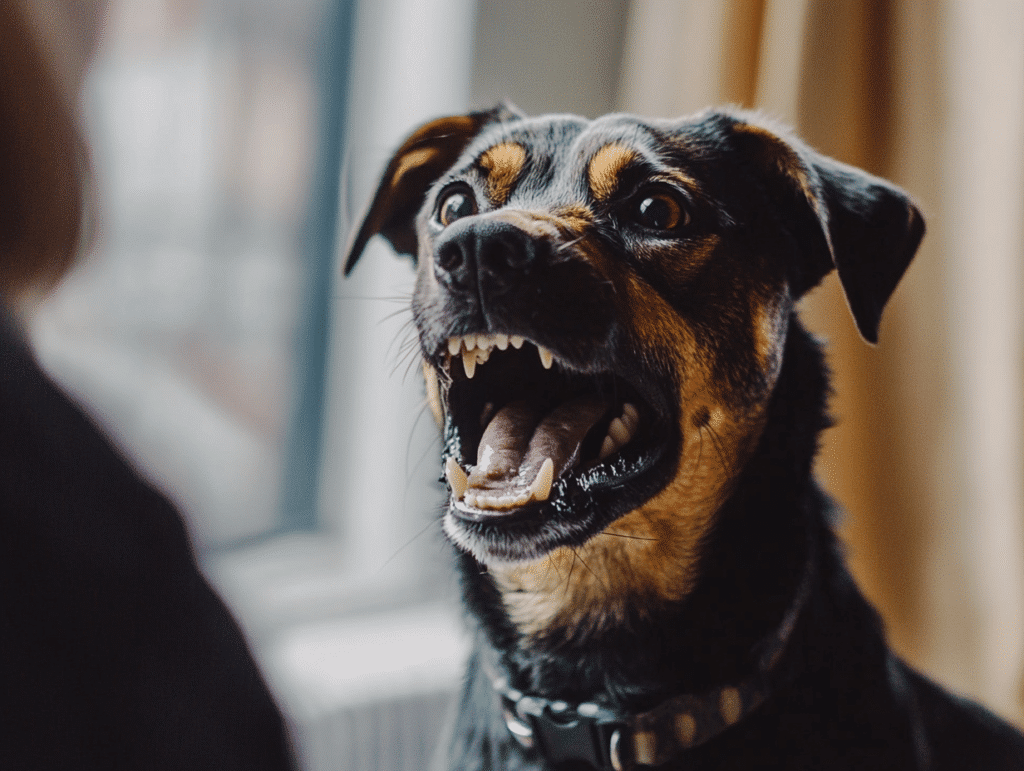In this blog post, we will discuss the various types of dog bite hand injuries, how to identify signs of infection, and share tips for preventing these injuries in the first place. Knowledge is power, and by arming yourself with this information, you can better protect yourself and your loved ones from the dangers of dog bites.
Were You Injured from a Dog Bite?
 Talk to Our Experienced Chicago Dog Bite Lawyer for Support.
Talk to Our Experienced Chicago Dog Bite Lawyer for Support.
Dog Bite Injuries to the Hand
Dog bite injuries to the hand can manifest in various ways, including lacerations, puncture wounds, and soft tissue damage. These injuries can lead to infections and complications if not treated promptly.
This section will explore various injuries resulting from dog bites and their potential implications for hand health and functionality.
Lacerations
Lacerations from dog bites are deep cuts that can penetrate the skin and reach the muscles, bones, nerves, or even blood vessels. These cuts can be severe and may require medical attention to close the wound and prevent infection. In fact, animal bite wounds in general can cause similar types of injuries.
The decision to stitch a dog bite laceration depends on the wound’s size and severity. If the injury is substantial or shows no signs of healing within 6 to 8 hours, you should seek immediate medical advice for an appropriate assessment and treatment. In certain circumstances, reporting animal bites to local authorities is necessary to avoid similar incidents in the future.
Puncture Wounds
Puncture wounds from dog bites are generally smaller yet deeper than other types of dog bite injuries, such as lacerations or abrasions. These wounds occur when the dog’s teeth pierce or puncture the skin, leaving a small hole on the surface. It is important to note that these wounds pose a high risk of infection due to the bacteria introduced by the bite.
The depth of a dog bite puncture wound on the human hand can vary depending on the situation, but these bites can cause deep puncture wounds that may penetrate multiple layers of tissue in the hand. Cat bites, which account for a significant number of animal bite injuries, can also cause deep puncture wounds. Immediate medical attention is crucial for these types of wounds, as they can lead to infections and complications if not treated properly.
Soft Tissue Damage
Soft tissue damage from dog bites can affect muscles, tendons, and ligaments, leading to pain and loss of function. Common types of soft tissue damage caused by dog bites include lacerations, torn flesh, crushing damage to the skin and soft tissue, and infection of the bite area.

- Pain
- Swelling
- Tenderness
- Discoloration of the skin near the injury
- Difficulty in movement
- Muscle spasms
- Paralysis
- Loss of sensation
It is vital to seek medical attention if any of these symptoms are experienced, as they can indicate serious complications and the need for professional care.
Recognizing Symptoms of Infection
Infections from dog bites can manifest as:
- Swelling
- Redness
- Pain
- Fever
These symptoms require immediate medical attention to prevent complications. This section will detail the possible symptoms of infection following a dog bite to help you discern when professional medical assistance is required.
Swelling and Redness
Swelling and redness around the bite area may indicate an infection. These symptoms can manifest within 3 to 5 days after a dog bite, but the time frame can vary from 1 to 14 days.
Cleaning the wound thoroughly with soap and water, applying an over-the-counter antibiotic cream, and covering the bite with a clean bandage are essential steps to reduce swelling and redness and prevent infection.
Pain and Discomfort
Pain and discomfort at the bite site can be a sign of infection or tissue damage. If pain and discomfort persist for more than 24 hours after a dog bite, it should be considered an indication of infection. Pay close attention to any increase in pain or the presence of other symptoms, such as redness, swelling, or discharge, as these may warrant immediate medical attention.
Fever and Other Systemic Symptoms
Fever and other systemic symptoms may suggest a more severe infection that requires urgent medical care. Common infections associated with dog bites include Pasteurella spp, Streptococcus, and Staphylococcus species, which can cause systemic symptoms such as fever, chills, redness, swelling, tenderness, and discharge of pus from the wound.
If you experience any of these symptoms, it’s essential to seek medical attention as soon as possible.
Immediate First Aid for Dog Bite Hand Injuries
Immediate first aid for dog bite hand injuries includes cleaning the wound, applying pressure to stop bleeding, and bandaging and elevating the hand.
The following section will detail each of these steps, providing guidance on how to effectively manage a dog bite hand injury.
Cleaning the Wound
Cleaning the wound with soap and water can help reduce the risk of infection. It is crucial to wash the wound thoroughly to remove dirt, bacteria, and other contaminants. An antiseptic solution, such as chlorhexidine or povidone iodine, is the most suitable solution for disinfecting a dog bite wound on the hand.
To clean a dog bite wound, follow these steps:
- Gently cleanse the wound with mild soap and warm water, ensuring all dirt, debris, and bacteria are removed.
- Avoid scrubbing or soaking the wound, as this can cause further damage or introduce additional bacteria.
- By taking the time to clean the wound properly, you can significantly reduce the risk of infection and promote healing.
Applying Pressure
Applying pressure to the wound can help control bleeding and minimize blood loss. To apply pressure to a dog bite wound on the hand, follow these steps:
- Use a clean cloth or sterile gauze pad.
- Apply gentle pressure to the wound to control the bleeding.
- Apply pressure for a minimum of 5-10 minutes to control bleeding effectively.
It’s essential to apply pressure using a clean cloth, sterile gauze pad, or a sterile bandage to prevent introducing bacteria or contaminants into the wound. If bleeding continues after applying pressure for the recommended time, seek medical attention immediately.
Bandaging and Elevating
Bandaging and elevating the hand can help reduce swelling and promote healing. To bandage a dog bite on the hand, follow these steps:
- Sanitize the area around the bite with mild soap and water.
- Pat dry and apply antibiotic ointment.
- Cover the wound with a sterile dressing or clean bandage.
Elevation is an essential component of treatment for dog bite injuries, as it aids in reducing swelling and minimizing pain. Here’s how to properly elevate the injured limb:
- Raise the hand above the level of the heart.
- Use pillows or a sling to support and elevate the limb.
- This will help reduce swelling and facilitate healing.
Were You Injured from a Dog Bite?
 Talk to Our Experienced Chicago Dog Bite Lawyer for Support.
Talk to Our Experienced Chicago Dog Bite Lawyer for Support.
Seeking Professional Medical Care
Seeking professional medical care for dog bite hand injuries is crucial to prevent infections and complications. The following section will discuss the circumstances that warrant medical attention and describe potential treatments, including antibiotics, tetanus shots, and surgical intervention if required.
When to Seek Medical Attention

In addition to the severity of the wound, other factors that may warrant medical attention include:
- Uncontrollable bleeding
- Difficulty breathing
- Weakness
- Crying or whining after a dog bite
It’s always advisable to seek medical evaluation for dog bite wounds to determine the appropriate course of treatment and prevent complications.
Antibiotics and Other Medications
Antibiotics and other medications may be prescribed to prevent or treat infections resulting from dog bites. The treatment of animal bites with antibiotics should be decided based on the severity of the wound, the overall health condition of the patient and their response to medication. Additionally, the appearance of injury also requires consideration when formulating a course of action. In some cases, inpatient antibiotic treatment may be necessary for underlying fractures.
In addition to antibiotics, other medications may be prescribed to manage pain, reduce inflammation, and prevent complications. Tetanus shots may also be recommended if the patient’s immunization status is uncertain or if the wound is particularly severe. It’s important to follow your healthcare provider’s instructions and take all prescribed medications as directed to ensure the best possible outcome.
Surgical Intervention
Surgical intervention may be necessary for severe dog bite hand injuries, such as repairing damaged tissue or treating deep infections. The depth, size, and location of the wound are all factors that must be taken into account when determining the necessity of surgical intervention after a dog bite to the hand. Additional factors may include the presence of residual dead tissue or infection, as well as the severity of the injury.
The most common surgical procedures for severe dog bite hand injuries involve washout and decontamination, debridement, and reconstructive surgery if necessary. Recovery time following surgery for a severe dog bite hand injury can vary but typically takes anywhere from a week to several months depending on the severity of the injury and the individual’s overall health.
Preventing Dog Bites to the Hand
Preventing dog bites to the hand involves teaching children about dog safety, recognizing aggressive dog behavior, and reporting animal bites to authorities.
The forthcoming section will elaborate on these strategies, aiming to assist you and your family in ensuring safety around dogs and minimizing the risk of dog bite injuries.
Teaching Children About Dog Safety
Educating children on how to approach and interact with dogs safely is crucial in reducing the risk of bites. It’s recommended that children between one to five years old be taught about dog safety, as young children are more likely to be subject to dog bites during this age range. Effective strategies for teaching children about dog safety include:
- Obtaining the owner’s consent before petting a dog
- Introducing themselves to dogs slowly
- Demonstrating affection through non-hugging and non-kissing gestures
- Not disturbing dogs while they are eating or sleeping
In addition to teaching children how to approach and interact with dogs, it’s important to help them recognize and avoid aggressive dog behavior. This includes paying attention to a dog’s body language, such as:
- intense staring
- raised hackles
- rigid body posture
- growling
- snarling
By teaching children how to recognize these warning signs, they can better protect themselves and others from dog bite injuries.
Finally, it’s essential to establish and enforce basic safety rules for interactions between children and dogs. This may include:
- Creating designated spaces in the home where dogs and children can have time apart
- Supervising all interactions between dogs and young children
- Teaching children to avoid interacting with dogs in certain situations, such as when the dog is eating, sleeping, or caring for puppies
Recognizing Aggressive Dog Behavior

- Barking
- Straining
- Biting
- Nipping
- Lunging
- Standing still and rigid with ears forward, mouth closed, tail high, and raised hackles
- Guttural bark that appears to be threatening
- Lunging forward or charging without contact
- Growling, snarling, and snapping
It is important to be aware of these warning signs and take appropriate action to prevent any harm.
It’s important to understand the underlying causes of aggression in dogs, such as fear, stress, or pain, in order to effectively recognize and prevent aggressive behavior. Here are some tips to help you handle an aggressive dog:
- Avoid physically confronting the dog, as this may increase the aggression.
- Try to remain calm and create distance between yourself and the dog.
- Seek help from a professional dog behavior specialist or trainer.
Reporting Animal Bites
Reporting animal bites to local authorities, such as animal control or the police, is essential for preventing future incidents and ensuring public safety. When filing a report of an animal bite, it is necessary to provide the following information:
- Date of the bite
- Particulars of the victim
- Information regarding the biting animal, including location, species, and any identifying information (e.g., rabies tag number)
Failing to report an animal bite can lead to a variety of repercussions, including:
- Lack of necessary documentation for a personal injury claim
- Criminal prosecution for the dog owner in cases of serious injuries
- Liability and potential penalties for the dog owner
- Delayed or inadequate treatment in hospital settings
- Possible fines or other related offenses
By reporting biting animals, including wild animals and human bites, you can help protect your community and prevent future incidents from occurring, as the severity of most animal bites depends on various factors. In some cases, even cat bites accounting for a small percentage of incidents can have serious consequences. It is important to report animal bites, be aware that human bites occur, too, and treat them with equal concern.
Frequently Asked Questions
What should I do if my dog bites my hand?
If your dog bites your hand, yelp loudly and remove your hand when he looks at you. Wash the wound, slow the bleeding with a clean cloth, apply over-the-counter antibiotic cream if available, wrap the wound in a sterile bandage and call your doctor right away if the bite is on the neck, head, face, hand, fingers or feet.
Is a dog bite on the hand serious?
A dog bite on the hand can be serious, as they can result in infections, pain, and other long-term problems.
What are the complications of dog bite to hand?
Dog bites can lead to infection, bleeding, pain, skin tearing, and potential muscle or bone injury, which can be severe in deep or more serious wounds.
What are the signs of infection after a dog bite?
Signs of infection after a dog bite include increased redness and pain around the wound, difficulty moving the body part, drainage, swelling, an abscess, fever, red streaks, and swollen lymph nodes. Immediate medical attention should be sought if any of these symptoms appear.
What is the best way to clean a dog bite wound?
It is best to clean a dog bite wound by washing it thoroughly with soap and water, then using an antiseptic solution such as chlorhexidine or povidone iodine to disinfect the area.












